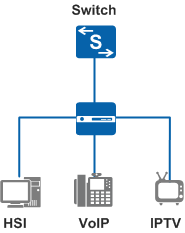Configuring Voice VLAN Capability of LLDP
Prerequisites
Before configuring the voice VLAN capability of LLDP on an interface, enable LLDP globally and on the interface.
Context
The voice VLAN capability of LLDP can change the transmission priority of voice data flows to ensure high-quality transmission of voice services.
As shown in Figure 1, a network transmits data flows of various services, including high speed Internet (HSI), voice over IP (VoIP), and Internet protocol television (IPTV). Voice services are sensitive to packet loss and delay. To ensure high-quality voice service, voice data flows need to be transmitted with a high priority through an exclusive path.
The traditional voice VLAN function allows network administrators to create a voice VLAN and add interfaces with voice devices attached to the voice VLAN. Then voice data flows are transmitted in the voice VLAN. Quality of service (QoS) parameters are configured for the voice data flows to increase their priority and improve the voice service quality. However, configuration of the traditional voice VLAN function is complex. Network administrators want a simpler and easier-to-use method to implement the voice VLAN function.
The device provides an easier method to implement the voice VLAN function: configure the voice VLAN capability of LLDP.

LLDP voice VLAN can only be configured on a physical Ethernet interface working in Layer 2 mode.
